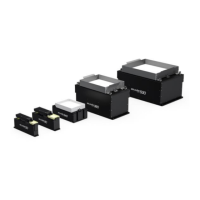interface is simplified as some parameters are regrouped.
Troubleshooting:
• Trajectory deviation:
If parts do not move precisely enough towards the desired target, you may want to
correct the trajectory with help of the other actuators. (Asycube 50 & 80: See
section 5.1, Asycube 240, 380 and 530: See section 5.2 or use the balance slider
in the Easy-Tune mode).
• Invisible wall or obstacles:
For certain parameters, parts seem to encounter an invisible wall/obstacle or their
movement differs depending on their position on the platform. Test different
phases, this might help achieve a more steady movement.
Make sure that the vibration duration for the standard platform vibrations corresponds to
the time the parts need to fully cross the platform. It is important to respect this; the
effectiveness of the Asycube depends on well-tuned parameters.
9.2.2. Hopper vibration/output activation
Place parts in the hopper (homogeneous filling). When tuning parameters it is important
that the conditions are as close as possible to the production situation. Depending if your
parts are sticky or present the tendency to bundle, using a dam might be helpful.
Perform the adjustments depending on your needs: You can either use a slower part
displacement in the hopper in order to obtain a better repeatability on the number of parts
fed (for the same vibration duration) or you can use a faster one, if you need a shorter
cycle.
• Asycube 50 & 80 (integrated hopper):
Adjust the frequency and amplitude.
• Asycube 240, 380 and 530:
Use the outputs to drive a hopper. You can select the output(s) that are active and
adjust signal amplitude from 0 to 100% (corresponding to 10 V) as well as the
duration of the signal. Please refer to the documentation for your specific hopper.

